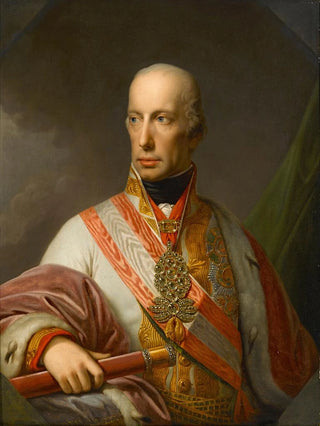Art print | A portrait of Emperor Francis II of Austria - Johann Baptist von Lampi the Elder


View from behind

Frame (optional)
Art print of a portrait of Emperor Francis II of Austria - Johann Baptist von Lampi the Elder – Captivating introduction
The art of portrait painting has always held a prominent place in art history, offering a fascinating glimpse into the historical figures who shaped our world. Among these portraits, the work of Johann Baptist von Lampi the Elder, depicting Francis II of Austria, stands out for its psychological depth and elegance. This painting, which evokes the majesty and complexity of the emperor, transports us to a time when power and culture were closely intertwined. The artist manages to capture not only the physical features of his subject but also the aura that surrounds him, revealing a character that is both human and regal.
Style and uniqueness of the work
Johann Baptist von Lampi the Elder's style is characterized by striking realism, combined with an artistic sensitivity that transcends mere portraiture. In this piece, the finesse of the details immediately draws the eye, whether in the texture of the emperor's sumptuous clothing or in the thoughtful expression of his face. The color palette, subtle and nuanced, plays a crucial role in the overall atmosphere of the painting. Delicate shadows and skillfully balanced lights create a depth that brings the canvas to life. This portrait does not merely freeze a moment in time; it tells a story, that of a man bearing the weight of his heritage. The composition, carefully balanced, guides the viewer's gaze toward the key elements while leaving room for imagination to explore Francis II's inner world.
The artist and his influence
Johann Baptist von Lampi the Elder, born in 1751, established himself as one of the most influential portraitists of his time. Trained in the academic tradition, he mastered technical rigor and artistic sensitivity. His work is not limited to simple representation; it aims to understand and convey the psychology of his subjects. Lampi had the opportunity to interact with many figures of European nobility, which allowed him to develop a style that combines grandeur and intimacy. His

Matte finish

View from behind

Frame (optional)
Art print of a portrait of Emperor Francis II of Austria - Johann Baptist von Lampi the Elder – Captivating introduction
The art of portrait painting has always held a prominent place in art history, offering a fascinating glimpse into the historical figures who shaped our world. Among these portraits, the work of Johann Baptist von Lampi the Elder, depicting Francis II of Austria, stands out for its psychological depth and elegance. This painting, which evokes the majesty and complexity of the emperor, transports us to a time when power and culture were closely intertwined. The artist manages to capture not only the physical features of his subject but also the aura that surrounds him, revealing a character that is both human and regal.
Style and uniqueness of the work
Johann Baptist von Lampi the Elder's style is characterized by striking realism, combined with an artistic sensitivity that transcends mere portraiture. In this piece, the finesse of the details immediately draws the eye, whether in the texture of the emperor's sumptuous clothing or in the thoughtful expression of his face. The color palette, subtle and nuanced, plays a crucial role in the overall atmosphere of the painting. Delicate shadows and skillfully balanced lights create a depth that brings the canvas to life. This portrait does not merely freeze a moment in time; it tells a story, that of a man bearing the weight of his heritage. The composition, carefully balanced, guides the viewer's gaze toward the key elements while leaving room for imagination to explore Francis II's inner world.
The artist and his influence
Johann Baptist von Lampi the Elder, born in 1751, established himself as one of the most influential portraitists of his time. Trained in the academic tradition, he mastered technical rigor and artistic sensitivity. His work is not limited to simple representation; it aims to understand and convey the psychology of his subjects. Lampi had the opportunity to interact with many figures of European nobility, which allowed him to develop a style that combines grandeur and intimacy. His






